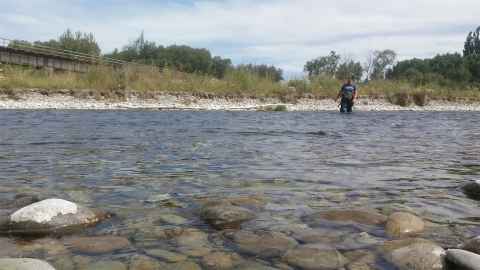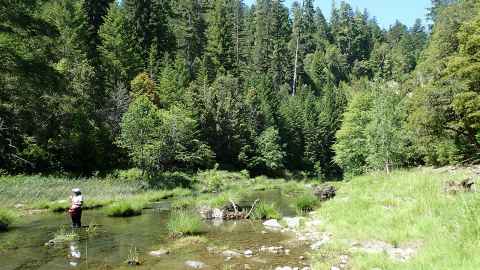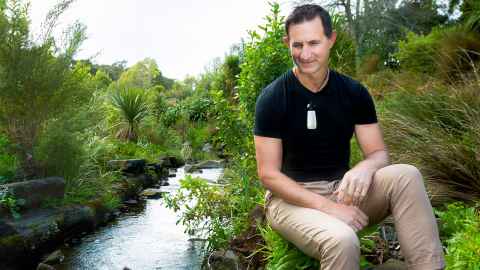He waka hourua rua ki te titiro ki te heke mai
3 December 2018
A double-hulled canoe to look into the future

If ever there was a moment when two worlds collided for earth scientist Dr Dan Hikuroa it was probably at Whakatāane’s Te Whare Wānanga o Awanuiārangi where he taught geology and Mātauranga – or Māori knowledge – as a PhD student. It got him thinking, “Wow, these two different ways of seeing and knowing the world were open to me and I was able to hold two opposing ideas simultaneously.”
We firmly believe that the most enduring solutions cannot be found in one body of knowledge in isolation.
Fast forward to 2018, where he is now a senior lecturer in Māori Studies at the University of Auckland, Dan is collaborating in a project funded by MBIE’s Te Pūnaha Hihiko: Vision Mātauranga Capability Fund that aims to improve the way in which scientists connect – and work – with Māori.
The Mātauranga research team includes ecologist Dr Cate Macinnis-Ng and environmental scientist Dr Tara McAllister, who Dan describes as the perfect candidate to lead the project because she can happily walk in both ways of knowing. “A remarkable young woman with a PhD in science, but also strong in te reo and with a solid and growing understanding of Mātauranga.”
Describing the partnership between the Te Pūnaha Matatini Centre of Research Excellence and the Canterbury-based environmental and resource management advisory firm Mahaanui Kurataiao Limited as he waka hourua rua ki te titiro ki te heke mai – a double-hulled canoe to look into the future – Dan says the proposal to work together with communities to identify the challenges they face came about through discussions about weaving Mātauranga and science across projects rather than just relying on scientific explanations and answers.
Collaboration is a key ingredient. As well as being a fundamental part of the University’s Centre of Excellence model, it is also a fundamental principle of teaching and learning in Mātauranga Māori. So much so that Dan says researchers and scientists need to recognise that they cannot simply march in without asking what benefits the community gains from engaging in this research. “If not driven by the community, these types of projects just don’t go anywhere.”
Unlocking the innovation potential of Māori communities and resources forms part of Mātauranga policy and Dan says his advice is that “we must ask communities what their challenges and dreams are and then try to co-create ways forward.”
As a ‘team’, the researchers, Mahaanui and the community will attempt to answer questions that the community wants answered drawing from all available knowledge. “If we’re just looking at science,” Dan says, “we don’t think it will deliver us the solutions. It’s our responsibility to bring together all knowledge. What’s more, we firmly believe that the most enduring solutions cannot be found in one body of knowledge in isolation.”
That means the researchers will draw from Kaitiakitanga (guardianship) as well as conservation ideas, cutting-edge science, and really old and new Mātauranga knowledge “because of course Mātauranga isn’t static, it’s dynamic, it’s constantly being added to and updated and tested” says Dan.

While the project is still in its infancy, it will be conducted in a reflective way so the research team can understand what works best for the different groups involved. From Dan’s perspective, tapping into Tara’s previous relationship with Mahaanui is “already beginning to deliver” on the intent of the Vision Mātauranga Capability Fund.
Capability building among individuals and groups is another positive, and Dan says that asking questions, and who gets to ask them, is important. “The mantra that I always bring to that is ‘progress, not perfection’. We’re always striving for it, but as long as we’re making progress, getting iteratively and incrementally better.”
One of the more potentially tangible outcomes is the intention to develop te reo science materials appropriate for school curricula, and kura kaupapa Māori language immersion schools, to make science more accessible to everyone.
Describing rangatahi (the younger generation) as “natural scientists anyway”, Dan says “we’re just trying to find mechanisms to engage our rangatahi with that learning.”
Another fundamental principle of teaching and learning in the Mātauranga Māori space is that success is not determined by who gets an A plus. “That wouldn’t be success in a Māori sense” says Dan. Success would be “everyone gaining an increased level of understanding on a particular thing that we’re interested in.”
Mātauranga, he says, is a process for generating knowledge which follows the same steps as the scientific method but is packaged and codified differently – so the idea is not to introduce the word science too early. In terms of curriculum resources, Dan says “we need to tailor them to what the Ministry of Education wants them to look like but we’re going to frame it from within a Māori worldview.”
While he accepts that Mātauranga Māori could be described as a holistic approach which tries to understand the system as a whole, Dan resists any temptation to label it as Māori science. Wearing his ‘political hat’ he prefers Mātauranga because “if we call it Māori science it could be viewed as another process of colonisation ... yet all those things we like about science, that it’s rigorous, that it’s precise, that it’s accurate, we can show that in Mātauranga as well.”
As a recognised expert on integrating indigenous knowledge and science, Dan has been involved in numerous environmental projects including Te Awaroa (Voice of the River) which aims to create a national movement of Kiwis taking action to care for waterways by understanding the issue from the perspective of the river.

Believing that scientific understanding is “out of balance” with Mātauranga, Dan wants to “flip how we’re thinking about rivers” – from what we can extract from them, to what the river would think. Inspired by the Te Awa Tupua Act (Whanganui River Act 2017), and the National Policy Statement on Freshwater Management that embraces Te Mana o te Wai, the Te Awaroa project combines scientific expertise with Mātauranga and community stories that has created a collective voice of the river which will lead to better decisions.
“We’re hoping that if we can bring together all of those voices as one and say this is what the river is saying, this is what the river wants, this is what the river needs – then we can frame it from the perspective of the river as opposed to the perspective of what humans need.”
Likewise, Dan is also critical of New Zealand’s approach to what some observers describe as “conservation by killing” whereby pests are eradicated and conservation land is locked up. An alternative way of thinking is the Te Pūnaha Matatini project entitled Mai i ngā maunga ki te tai (from the mountains to the oceans), which seeks to address pressing environmental issues by drawing on all bodies of knowledge rather than just relying on a scientific explanation.
According to Dan, it’s time to start thinking about the kinship-based approach embodied in Kaitiakitanga. “Kaitiakitanga is about managing those relationships we have with the Taiao (natural world) in a balanced way.”
For those trying to fathom his philosophy on all this, the digital signature on his University of Auckland email account just might hold the key:
Whatungarongaro he tangata, toitū he whenua
People pass on, but the land is permanent
inSCight
This article appears in the December 2018 edition of inSCight, the print magazine for Faculty of Science alumni.